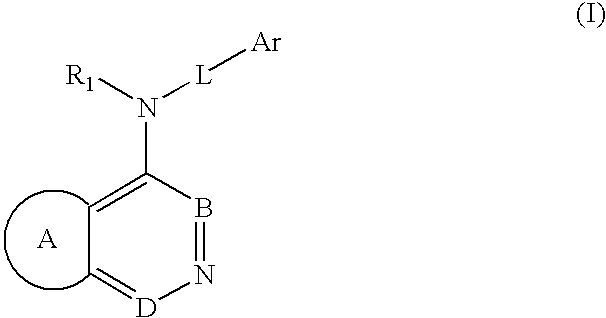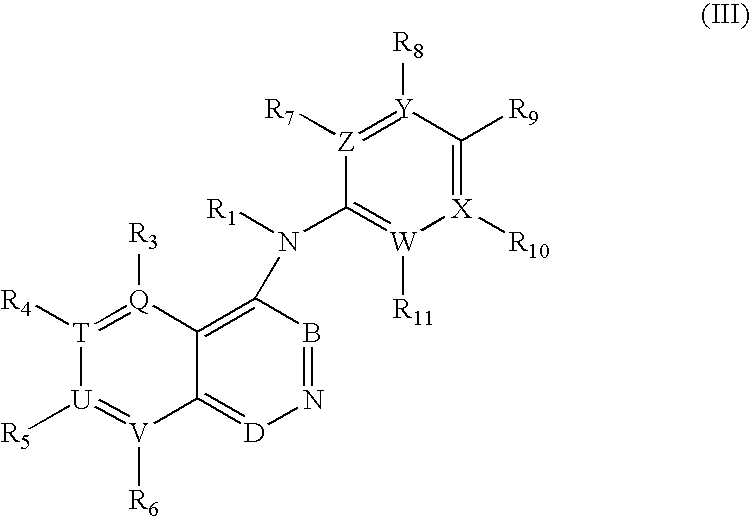Pharmaceutical compounds as activators of caspases and inducers of apoptosis and the use thereof
a technology of apoptosis and activator, which is applied in the field of medicinal chemistry, can solve the problems of bone marrow toxicity, cancer cells losing their capacity to undergo cell suicide, and cancer cells becoming cancerous
- Summary
- Abstract
- Description
- Claims
- Application Information
AI Technical Summary
Benefits of technology
Problems solved by technology
Method used
Image
Examples
example 1
[0244]
[0245]To a suspension of 3H-Benzo[d][1,2,3]triazin-4-one (0.502 g, 3.4 mmol) in toluene (5 mL) was added diisopropyl ethyl amine (1.2 mL, 6.9 mmol) and phosphorus oxychloride (0.5 mL, 5.4 mmol) at −78° C. under argon. The reaction mixture was stirred at room temperature for 75 min, then diluted with EtOAc (50 mL) and washed with water (15 mL). The aqueous layer was extracted with EtOAc (2×50 mL). The EtOAc solutions were combined, washed with saturated NaHCO3 (15 mL), dried, and evaporated to give a brown solid.
[0246]The above crude product was stirred with N-methyl-4-methoxy-aniline (138 mg, 1 mmol) in isopropanol (10 mL) at room temperature for 26 h. The solvent was evaporated and the residue was stirred with EtOAc (50 mL) and saturated Na2CO3 (15 mL). The EtOAc layer was separated, washed with 1M citric acid (10 mL), dried with MgSO4, and evaporated. The brown residue was purified by column chromatography (SiO2, EtOAc:hexanes / 10-50%) to give a light brown solid. The solid w...
example 2
[0247]
[0248]A solution of 2H-Phthalazin-1-one (1.01 g, 5 mmol) in phosphorus oxychloride (5 mL) was stirred at 130° C. for 1.5 h. The phosphorus oxychloride was removed under reduced pressure. The residue was partitioned between water (10 mL) and methylene chloride (50 mL). The methylene chloride phase was separated, dried over MgSO4, and evaporated to give a yellow solid (1.015 g, 90%).
[0249]The above crude product (83 mg, 0.50 mmol), N-methyl-4-methoxy-aniline (69 mg, 0.50 mmol) and cesium carbonate (200 mg, 0.61 mmol) were stirred in anhydrous DMF (1 mL) in a sealed tube at rt for 17 h. The reaction was diluted with water (5 mL) and extracted with EtOAc (2×20 mL). The EtOAc solution was washed with water (5 mL), dried, and evaporated to give a brown residue. The crude product was purified by column chromatography (SiO2, EtOAc:hexanes / 15-50%) to give a light yellow solid (5 mg, 4%): 1H NMR (CDCl3) 9.11 (s, 1 H), 7.85 (m, 1 H), 7.66 (m, 1 H), 7.48-7.47 (m, 2 H), 7.40-7.10 (m, 2 H),...
example 3
[0250]
[0251]Benzo[d][1,2,3]triazin-4-yl-(3,4-dimethoxyphenyl)-amine was synthesized using a procedure similar to (4-methoxyphenyl)-methyl-(6-methylbenzo[d][1,2,3]triazin-4-yl)-amine. 1H NMR (DMSO-d6) δ 9.84 (br s, 1 H), 8.58 (d, 1 H), 8.18 (dd, 1 H), 8.12 (td, 1 H), 7.96-8.04 (m, 1 H), 7.36-7.54 (m, 2 H), 7.04 (d, 1 H), 3.80 (s, 3 H), 3.79 (s, 3 H). MS (ES) 281 (M−H), 283 (M+H).
PUM
| Property | Measurement | Unit |
|---|---|---|
| humidity | aaaaa | aaaaa |
| pH | aaaaa | aaaaa |
| temperature | aaaaa | aaaaa |
Abstract
Description
Claims
Application Information
 Login to View More
Login to View More - R&D
- Intellectual Property
- Life Sciences
- Materials
- Tech Scout
- Unparalleled Data Quality
- Higher Quality Content
- 60% Fewer Hallucinations
Browse by: Latest US Patents, China's latest patents, Technical Efficacy Thesaurus, Application Domain, Technology Topic, Popular Technical Reports.
© 2025 PatSnap. All rights reserved.Legal|Privacy policy|Modern Slavery Act Transparency Statement|Sitemap|About US| Contact US: help@patsnap.com



